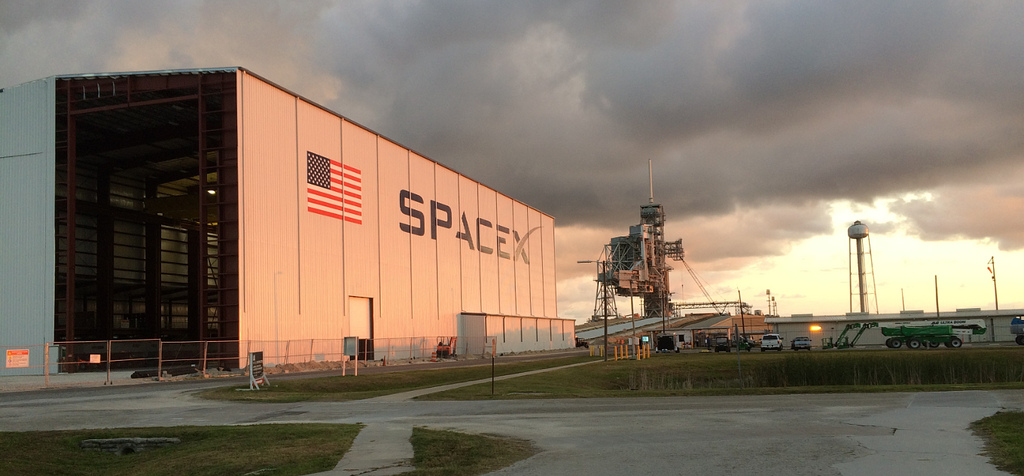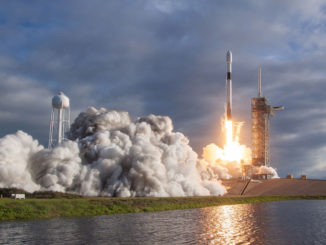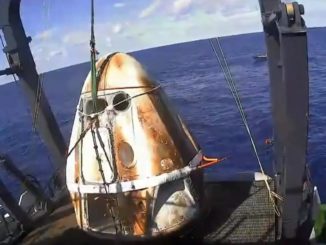
The next test of a critical safety system on SpaceX’s human-rated Dragon spaceship will be delayed, likely until at least late next year, as the company adjusts the development schedule for the new commercial crew capsule designed to take astronauts to the International Space Station.
The in-flight abort demonstration, which is designed to prove the Dragon’s escape rockets can carry a crew away from an exploding rocket, will occur from launch pad 39A at Kennedy Space Center in Florida, according to an update posted July 1 on NASA’s website.
The abort test was previously expected to go from Vandenberg Air Force Base in California.
SpaceX completed a successful test of Dragon’s abort system May 6 from a launch pad in Florida, verifying the capsule’s eight side-mounted SuperDraco thrusters can quickly power the spacecraft away from a failing rocket while it is still on the ground.
Company officials said in May the second abort test in the Crew Dragon program would occur later this year. A schedule of development milestones released by NASA in April indicated the in-flight abort demo was set for no earlier than September.
But SpaceX will now conduct the in-flight test of the Crew Dragon’s abort jetpack after an unmanned orbital demonstration flight of the human-rated spaceship. SpaceX officials previously said the unpiloted orbital demonstration flight would occur in late 2016, implying at least a one-year slip in the Dragon’s second abort test from late this year.
The new plan calls for SpaceX to refurbish the capsule flown on the uncrewed test for the in-flight abort demo. If the tests go according to plan, SpaceX will launch the Crew Dragon’s first mission with astronauts on-board some time in 2017.

“Testing the actual flight design always results in higher fidelity data and ultimately reduces risk for later crew flights,” said Bill Gerstenmaier, associate administrator of the NASA’s human spaceflight programs. “This change supports a philosophy of testing as you fly, which our experience has shown to be a good strategy for development and complements well the earlier system information gained from the pad abort test.”
SpaceX engineers are evaluating the results of the May 6 pad abort test, in which the prototype Crew Dragon rocketed away from Cape Canaveral’s Complex 40 launch pad, reached an altitude of nearly one mile, and splashed down under parachutes just offshore in the Atlantic Ocean.
Officials said data from the test showed a slight underperformance of the SuperDraco jetpack, and capsule did not reach the top speed and altitude targeted by engineers. But the test was successful by NASA’s standards, and the space agency awarded SpaceX a $30 million milestone payment after data reviews.
The pad abort test occurred nearly two years after it was originally scheduled in a funding agreement SpaceX signed with NASA in 2012. The delays are a big reason why SpaceX decided to change the Crew Dragon’s test sequence moving forward.
“Since the pad abort vehicle began production more than two years ago, SpaceX has refined the Crew Dragon’s design, and the planned design now differs from the pad abort vehicle design,” NASA said in a statement. “As a result, using the pad abort vehicle to conduct the in-flight abort test would not provide the best quality data. SpaceX can further reduce risk for later crewed flights and improve the fidelity of the data by using a Crew Dragon built to the current design.”
The in-flight abort is part of SpaceX’s Commercial Crew Integrated Capability, or CCiCap, agreement with NASA signed in August 2012. The agreement to complete development milestones under the agreement has been extended before, and NASA said the deadline will be pushed back again to accommodate the date change for the in-flight abort.
NASA awarded SpaceX and Boeing separate contracts in September 2014 worth up to $2.6 billion and $4.2 billion, respectively, to finish development of the Crew Dragon and CST-100 commercial crew capsules and fly astronauts to and from the space station, ending U.S. reliance on Russian vehicles for the job.
SpaceX is building and modifying facilities at Kennedy Space Center’s launch pad 39A for launches of the company’s Falcon 9 and Falcon Heavy rockets. The company has installed a new fuel farm to store RP-1 propellant for the boosters, and a new hangar has been constructed over the former space shuttle-era crawlerway at the southern perimeter of the launch pad.
The company aimed to fly the first Falcon Heavy rocket from launch pad 39A before the end of 2015, but SpaceX’s launch schedules are on hold after a June 28 Falcon 9 rocket failure.
As of late June, construction crews had erected the hangar’s structure, installed cranes and were preparing to assemble a transporter-erector to haul rockets up the ramp to the launch pad.
Email the author.
Follow Stephen Clark on Twitter: @StephenClark1.



